The Turpan depression is the lowest point in China, and the second
lowest in the world after the Deadd Sea, at 155 meters below sea level.
It's also the hottest place in China, with a recorded high of 48°C.
Turpan was also my first exposure to Xinjiang, even if it was almost 800
km from the border with Gansu. As the bus from Dunhuang was ultimately
headed for Urumqi, I was dropped off at the northern end of town, where
the highway clips the edge of town.
I had no idea where I was but started walking south along a major road. I
eventually reached town, but even at 8:00 in the morning I had to stop a
few times to cool down. After walking around the center of town for a
bit, I headed to the Turpan Hotel—which was supposed to have
dorms—hoping that they still accepted foreigners. It took a while for
the English-speaking attendant to show up, but she said I would be able
to check in later—I think they accepted foreigners because they were a
large three-star hotel that also hosted tour groups in their main hotel
operations.
When I checked in that afternoon, I discovered that the dorms were
actually located in the basement of a side building whose entrance was
to the right of the main hotel entrance steps. Lots of people seem to
complain about these dorms, but in my mind they were actually pretty
good: 3 beds in an air-conditioned room with a TV and attached bathroom
featuring a western toilet, and daily cleaning from hotel staff, all for
the typical hostel price 50 yuan per night. Given that hostels usually
lack AC and are much dirtier, being in a fairly dark and humid room
(there was window high up on the wall, but always closed since people
tend to use AC instead) was fine with me, especially since I didn't plan
on being there that much.
Emin Ta Minaret aka Sugong Ta
After dropping my bag at the hotel, I decided to see one of the major attractions in Turpan: the
Emin Ta Minaret.
You can take bus 1, 6, or 102 to get there. I took bus 6, which takes
back streets and drops you off near the rear entrance to the mosque. I
ended up walking all the way around to the front entrance because I
couldn't read the signs pointing out the shortcut access, which seemed
to indicate it was an exit only. It was a pleasant walk through empty
backstreets bordering on grape fields, and much more interesting than
simply being dropped off directly at the entrance.
Anyway, a bigger problem is that Lonely Planet calls it Emin Ta—and only
gives the Chinese characters for Emin Ta—when everybody local calls it
Sugong Ta and the signs and buses only use this name (苏公塔). This makes
it kind of tough to tell if you're getting on the right bus, not least
since the buses don't all seem to have numbers on them.
The back roads that bus 6 takes you over is a nice introduction to
Xinjiang, however, as you pass through dusty streets lined with
mud-brick houses—all very monochrome and Central-Asian looking. Between
this kind of architecture and the poplar trees, this is the sort of
landscape I was expecting, and hoping, to see in Central Asia. Dunhuang
may have offered a taste of it, but this is where it really felt like
the Silk Road was beginning.
 |
| Muslim cemetery near Emin Ta, with typical Turpan lattice-brick grape-drying houses in background. |
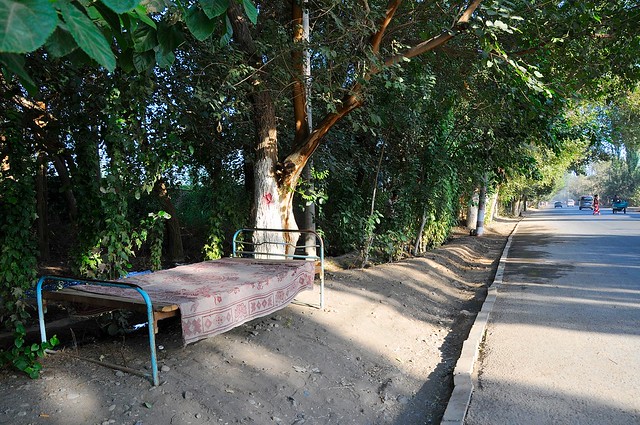 |
| Beds in front of houses and in the streets are a common sight in scorching-hot Turpan. |
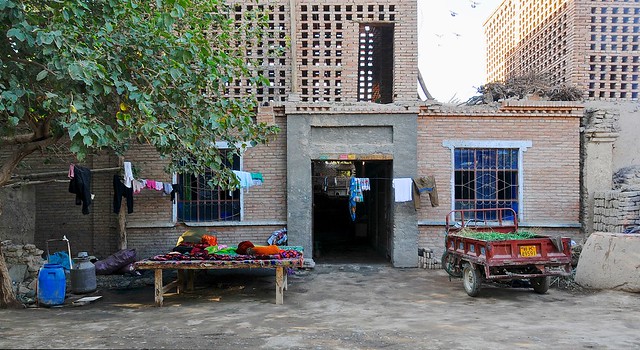 |
| Living quarters below, grape-drying on top, and sleeping platform out front. |
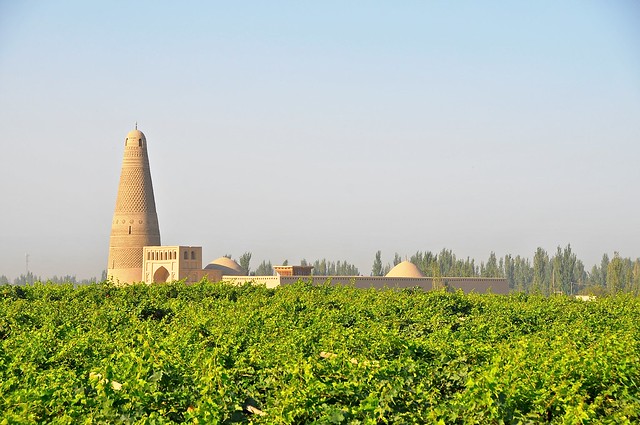 |
| View of Emin Ta over grape vines. |
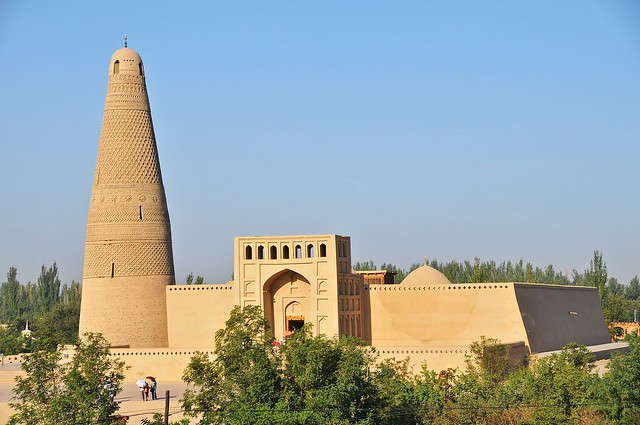 |
| The minaret is 44 meters high and richly ornamented with decorative brickwork. |
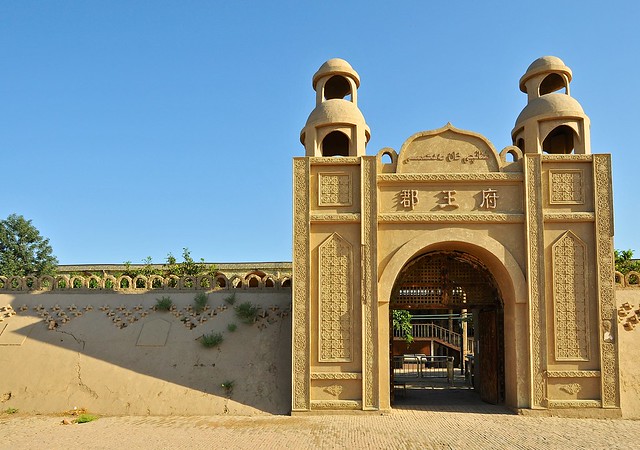 |
| Modern admission gate to the mosque complex. |
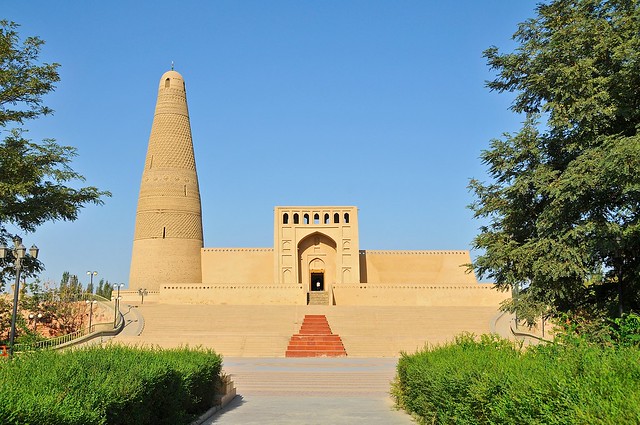 |
| Below the mosque's main entrance. |
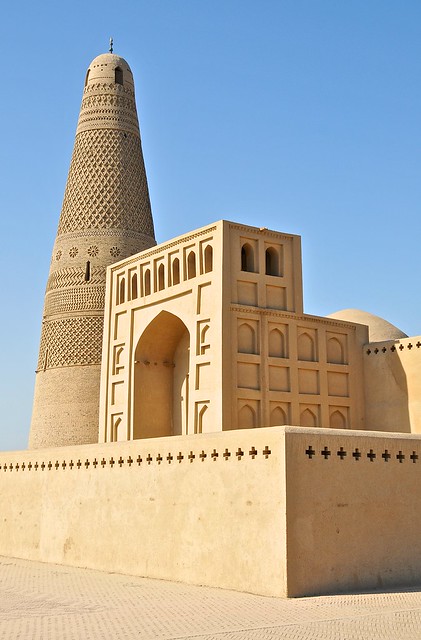 |
| Behind the outer wall. |
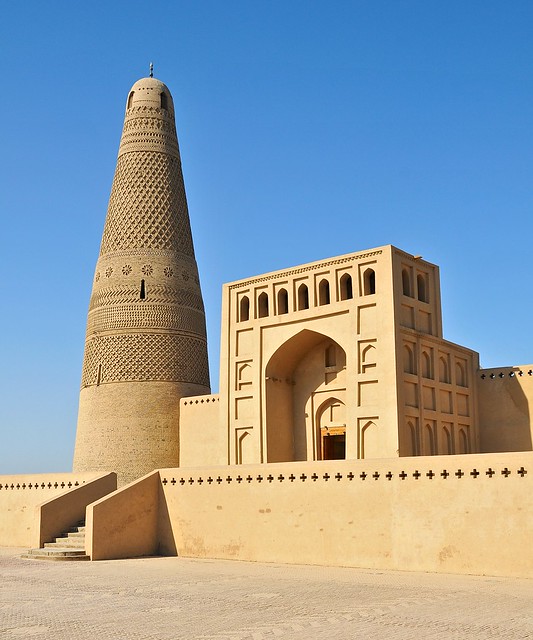 |
| The mosque is a recent reconstruction, but the minaret is original. |
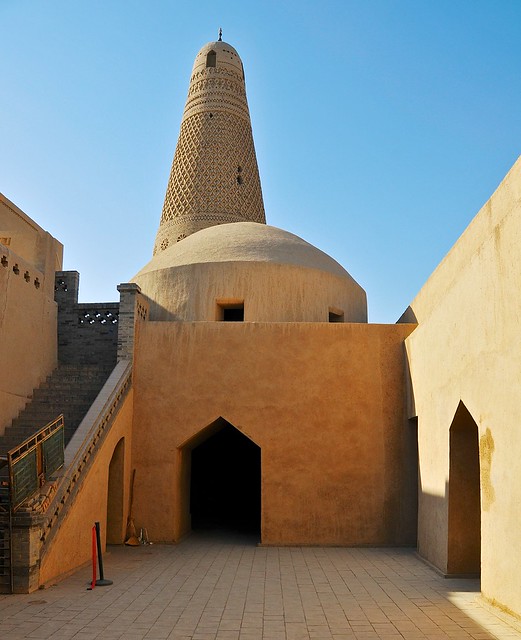 |
| You used to be able to climb the minaret but you can no longer do so. |
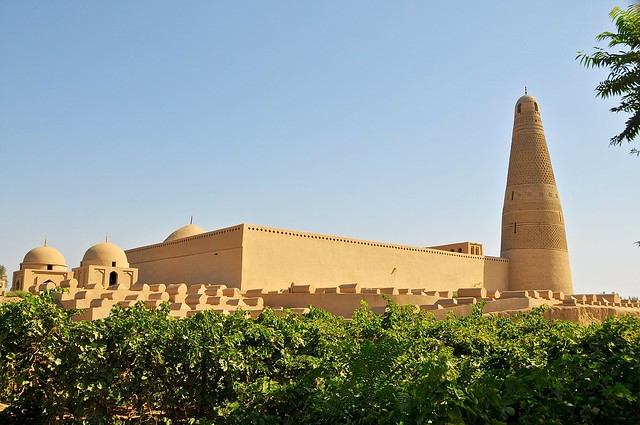 |
| There are graves surrounding the mosque. |
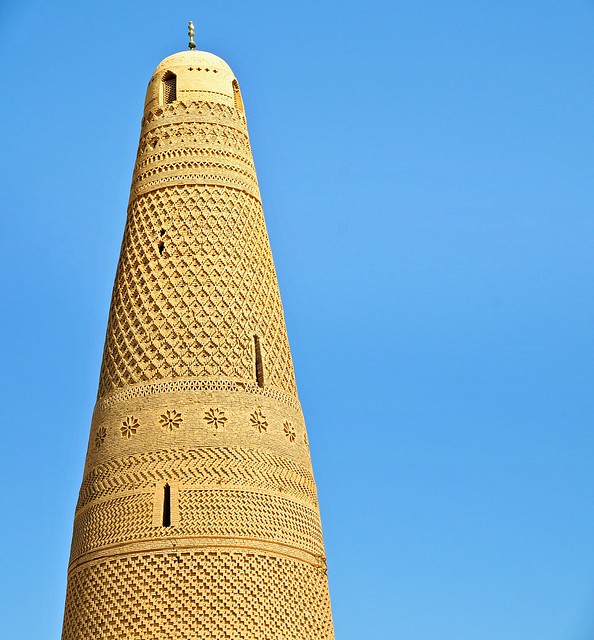 |
| There are fifteen different bands of brickwork on the minaret, almost all of which are on the upper sections. |
 |
| View from the base. |
 |
| Ruins and timeless drying houses. |
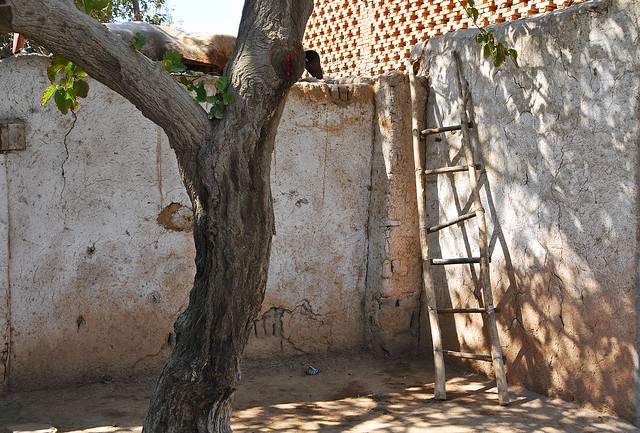 |
| This looks like it could be from 100—or 500—years ago. |
After visiting the minaret, I returned to town via the main road. One of
my first stops was a market on the main road, and I was a little
surprised to see how different everything was compared to your markets
even in Dunhuang. There were all sorts of products unique to Xinjiang,
so much so that it was almost like being in a different country. Instead
of simply having soft drinks like Coke and Fanta, and their Chinese
knockoffs, there were all sorts of other drinks, from pomegranate to
black currant to jujube. It was really weird, and I remember having no
idea of how much anything should cost, since I had never seen these
kinds of products before. I think this showed up in my quizzical look
when I went to pay, and I believe I was overcharged significantly—but
since it seems to be the only time I was ever overcharged in Xinjiang
it's difficult for me to conclude I was.
Turpan Museum
On the way back from Emin Ta I stopped by the new and modern Turpan
Museum, which rises to the high standards set by other Chinese museums.
Although you have to check your bags in lockers before you enter the
museum, you are allowed to take your camera with you.
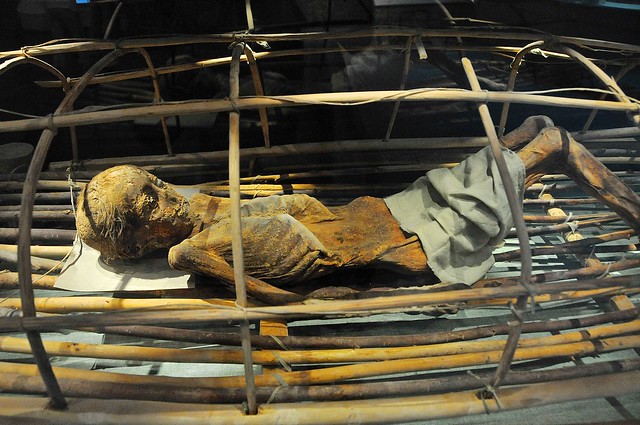 |
| One of the mummies n display. A lot of mummies in the arid Taklamakan Desert region have survived. |
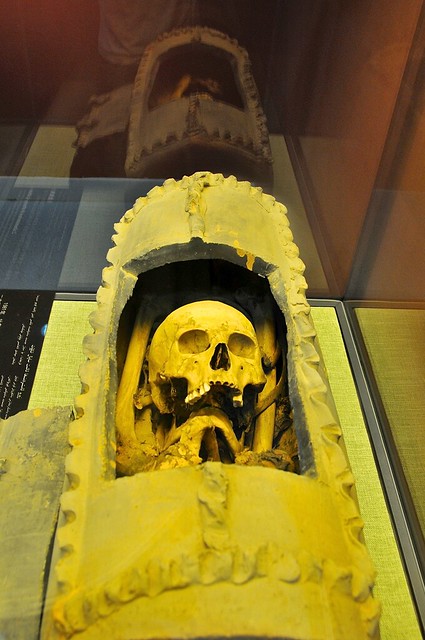 |
| A coffin into which the bones of the deceased are placed. |
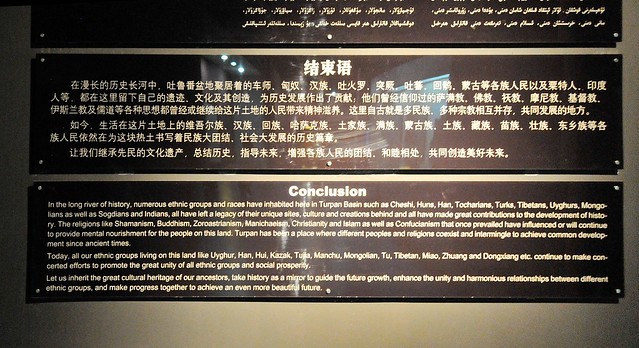 |
| Typical Chinese
museum propaganda about how unified and harmonious the country has
always been. These kinds of messages are especially prominent in
minority regions. |
Around Jiaohe
After visiting the museum, I headed back to the hotel to check in. I
then explored around the hotel and checked out the bus schedules, then
took bus 102 towards Jiaohe, If you get off at the last stop, you're
about 5 km away from Jiaohe, and you just keep following the road until
you arrive.
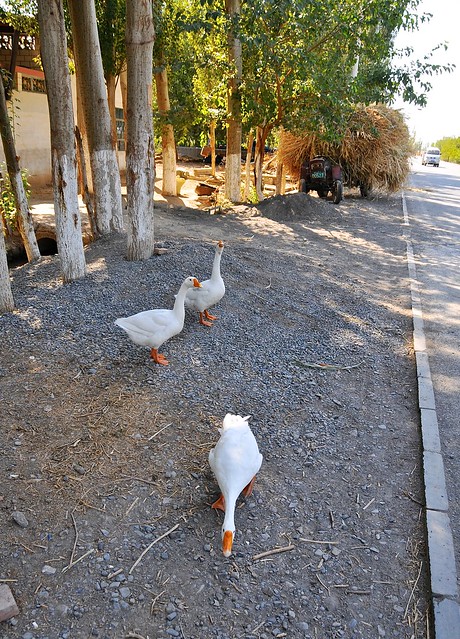 |
| Geese in front of
a farmer's yard. The Romans used to use Geese as guard-dogs to alert
the Emperor to intruders, and after seeing these territorial geese I can
understand this. |
 |
| Old tractor carrying a load of straw on the road to Jiaohe. |
When you get near Jiaohe you will find a very touristy historical
amusement park on your right, just after the road dips down into a river
valley. Since it was already 5:30, I figured I wouldn't be able to see
Jiaohe, so I went down into the valley and followed the river to the
nearby reservoir it fed into, then climbed the bluffs opposite Jiaohe.
 |
| This traditional
house was just off the road near the amusement park, but on the opposite
side. Beds in the courtyard, hay on the roof, and a goat in the shade. |
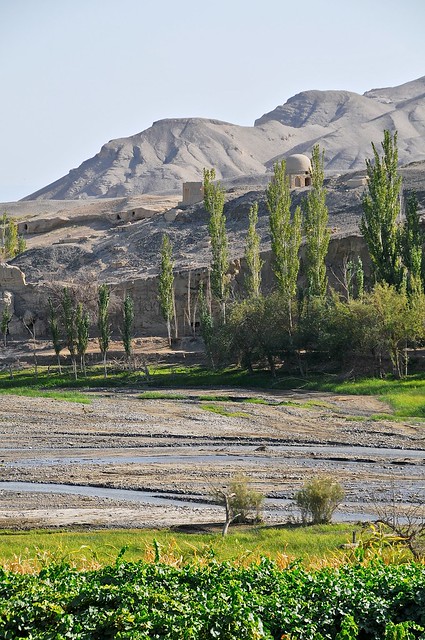 |
| The river valley, with tombs on the bluff. |
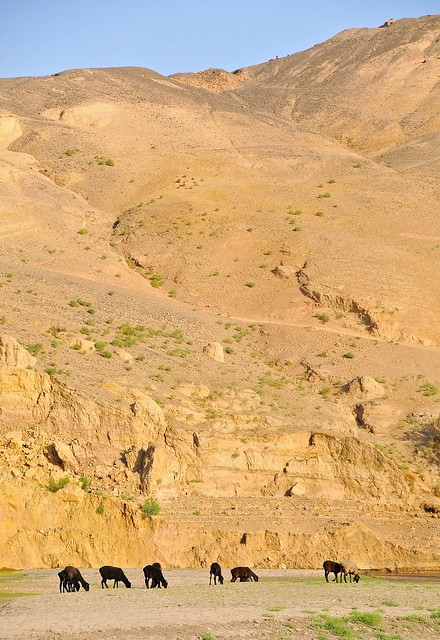 |
| The eastern bluffs in the evening sun, with livestock grazing in the river delta. |
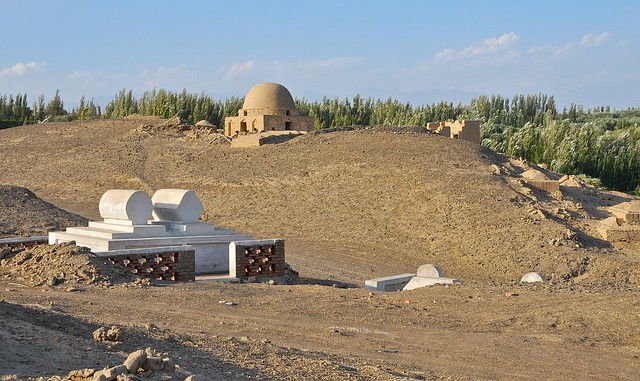 |
| The cemetery and tombs on the western bluff. |
 |
| A Muslim tomb, with a row of graves in front. |
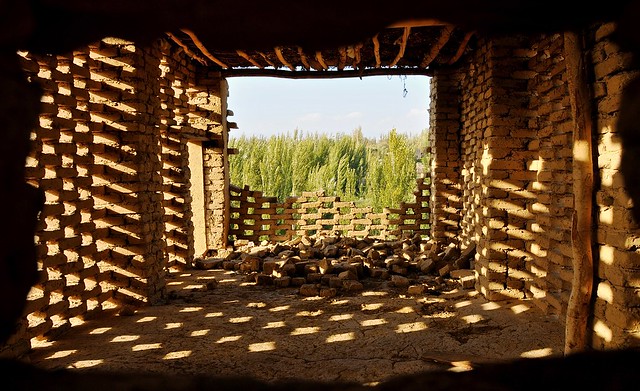 |
| The interior of a crumbling grape-drying house. The brickwork lets air circulate, but protects against the harshest sun. |
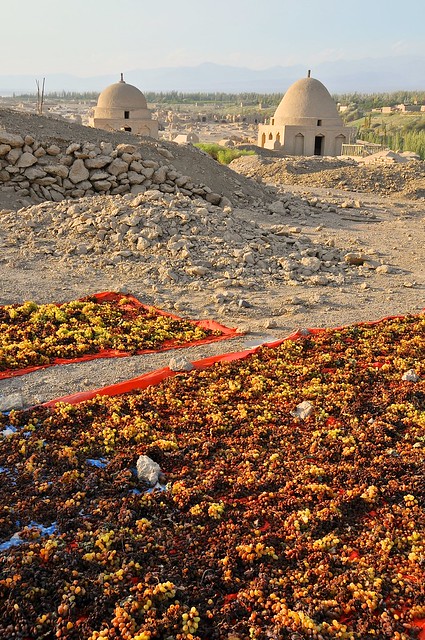 |
| Grapes drying on fabric. |
 |
| Grape-hanging
racks stacked against a drying house. Security fences in the background
keep people out of a large rocky desert area. |
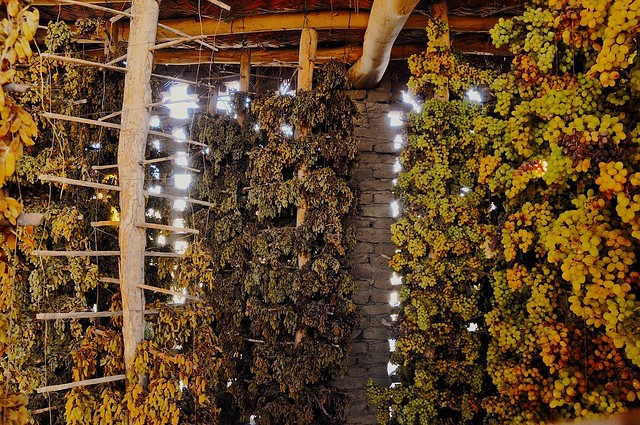 |
| Fresh grapes hanging from the racks within. |
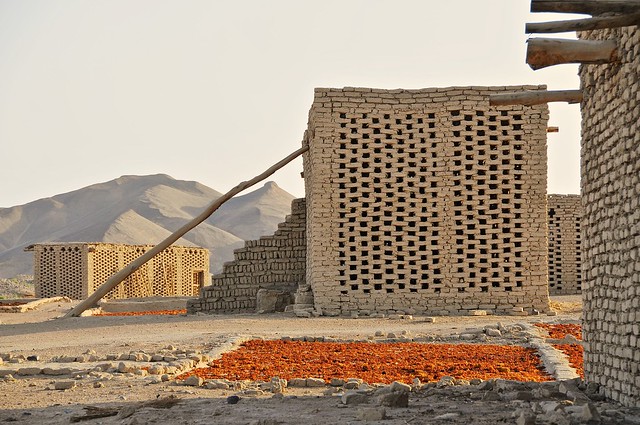 |
| The houses and drying pits are everywhere. |
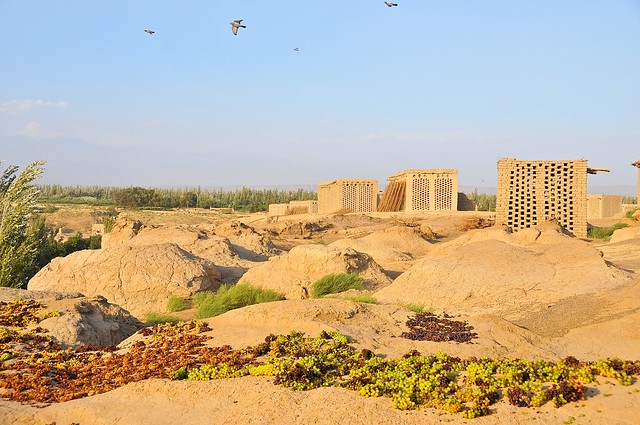
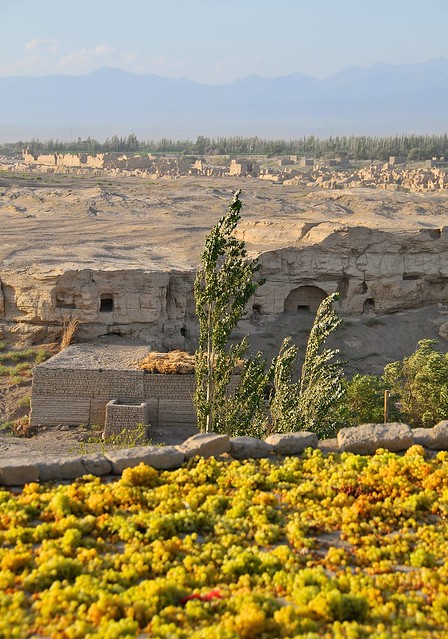 |
| You can see
Jiaohe across the way—it's on an island between two canyons formed by
seasonal, historical rivers, with caves carved into the bluffs. |
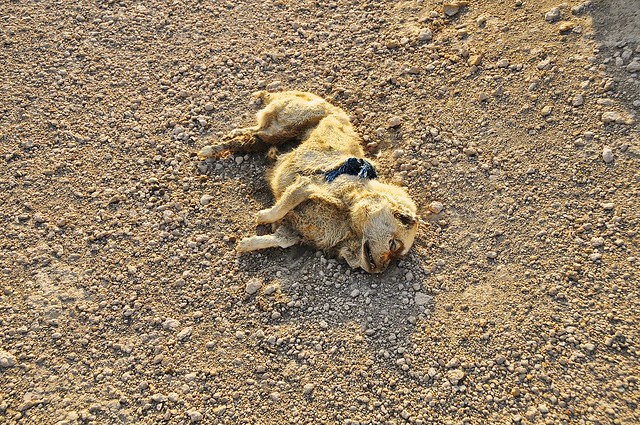 |
| Grapes aren't the only thing that dries here—this dog is pretty well mummified. |
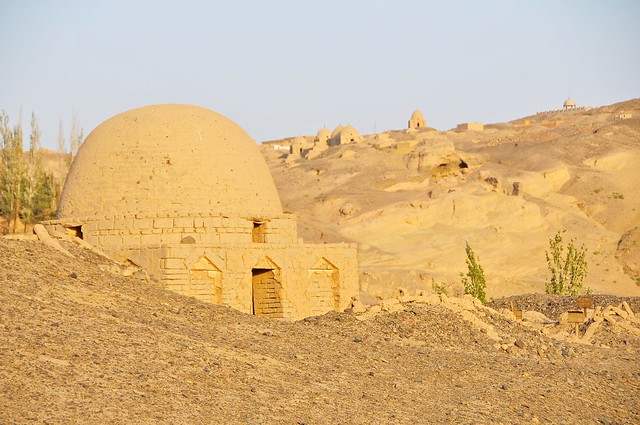 |
| You can see more tombs across the river valley, to the east. |
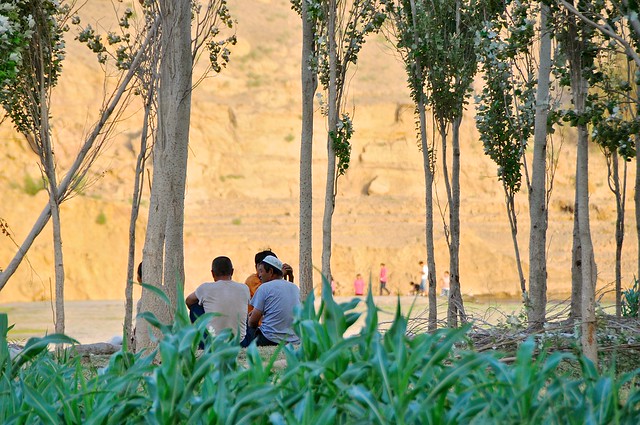 |
| Locals gather by the stream in the evening. |
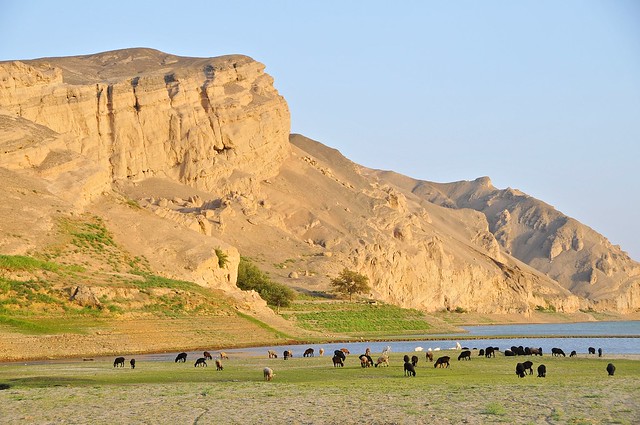 |
| The river empties into a reservoir, dammed at the other end. |
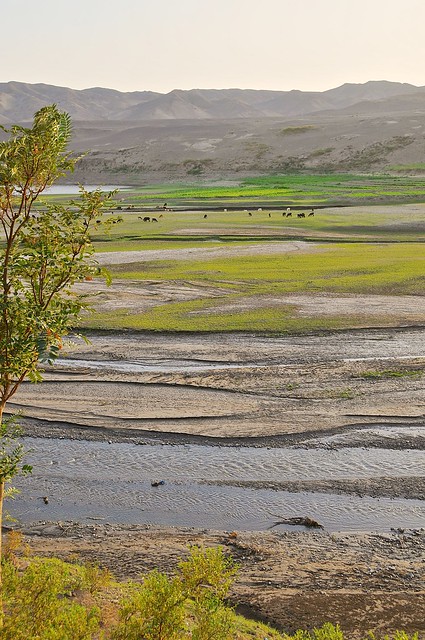 |
| From midway up the eastern bluffs. |
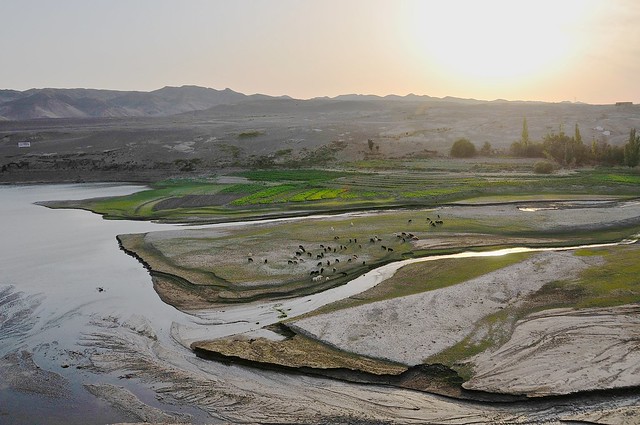 |
| The entire area in the background was fenced off and monitored with security cameras. |
 |
| More tombs and graves on the eastern bluff. |
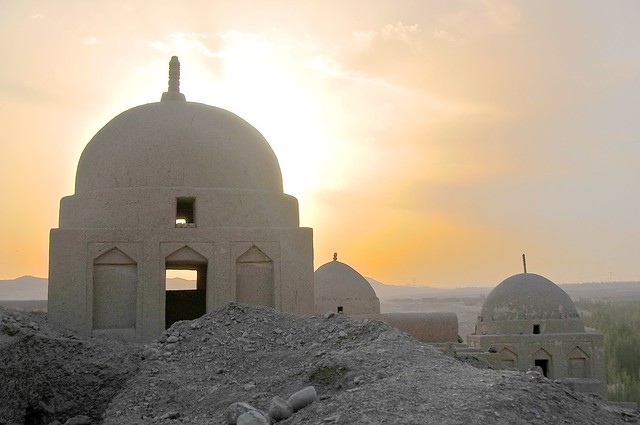 |
| Looking at the eight O'clock sun. |
 |
| The eastern side of the river has even more grape-drying houses. |
 |
| Everyone on their way home from work in their trikes. Pity about all the garbage on the left. |
I went out for dinner at the night market across from the bus station
that night, and tried some local soups. For the first time in China, I
was approached by curious locals who wanted to talk to me (I get a lot
less attention than other Western tourists because I'm not completely
white, and it's really only those who are distinctively white that are
held in high esteem). The first was a middle-aged Uyghur who was curious
about where I was from and where I was going. He was later joined by a
younger guy whose designs were clearly more mercenary, and with whom the
older guy was uncomfortable: the older guy has asked if I had any
pictures of Canada or where I come from, and I didn't have anything but
some coins, which I showed him, and then gave him some which he
reluctantly accepted. The younger guy wanted to know if I had any paper
money, but I said I only had US dollars, and he said he would trade me
some Chinese currency as a 'souvenir'... except he wanted to trade for
multiple US bills at bad exchange rates. I told him that if I did that
he would just to go the bank the next morning and change them back to
yuan at a big profit, but he pretended not to understand. It was
interesting, and despite the late scamminess of the younger guy, the
vibe of the crowd and the locals at the market was much more welcoming
and friendly than I saw anywhere in Han China.
Jiaohe
The next morning I stayed around the hotel for most of the morning until
I checked out, exploring the parks and paths nearby. The road in front
of the hotel, like many pedestrian walkways in the area, was covered
with grape vines, giving shade to hose underneath. There were big
bunches of grapes hanging from these vines, and you could occasionally
jump high enough to grab them.
Despite being a desert region, Xinjiang is famous for its fruit. Turpan
is famous for its grapes, and the eastern town of Hami is famous for its
melons—known as Hami melons. And Uyghur really love their melons. In
any Uyghur city you're likely to see someone with a wooden cart piled
high with melons, surrounded by a crowd as he cuts slices of the
juiciest melon you've ever had. Depending on the type of melon, it might
be 1 yuan for a slice or 2 yuan: the orange-fleshed Hami melons are
more expensive. The melons are so juicy that your hands and face will be
wet (the melon man's hands get wet just from slicing the darn things),
so there will always be a rag on the cart for you to wipe your hands on.
Anyway, in the afternoon I headed back to Jiaohe, again taking bus 102
and walking; I can confirm that it does get hot in Turpan in August.
Jiaohe
is mostly unrestored, or very lightly restored, with the net effect
being that it looks like a bunch of mounds of dirt arranged in the rough
outlines of buildings. Some sections are better preserved than others,
and some are lightly restored into something more closely resembling
walls and buildings, but you'll have to use your imagination. Although
it gets a fair bit of tourist traffic, almost all tourists are on group
tours and they all stick to the main path and boardwalk; if you venture
out to the sides you'll encounter very few people. Admission was 40
yuan.
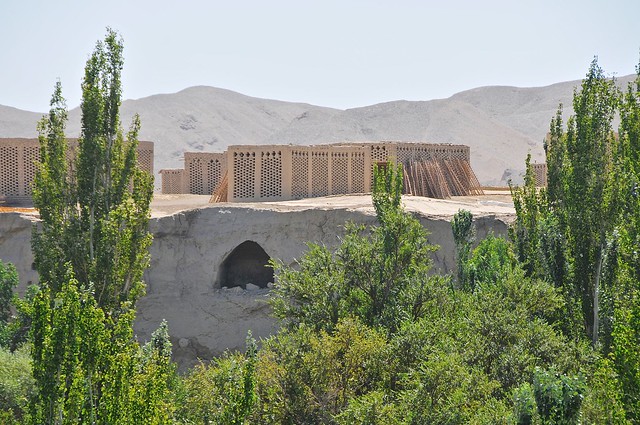 |
| Looking south from Jiaohe, at where I was the day before. |
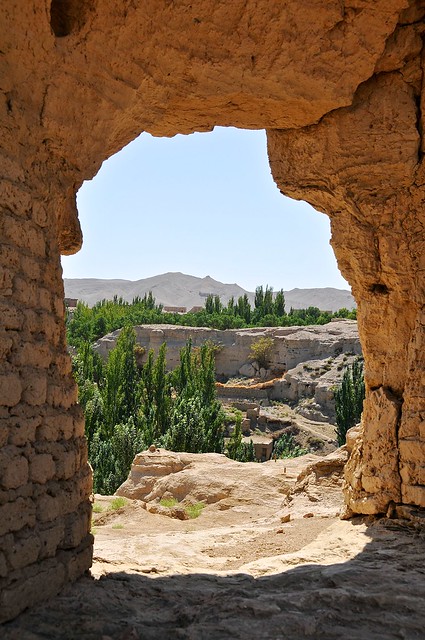 |
| From within an arched ruin, with some obvious light restoration. |
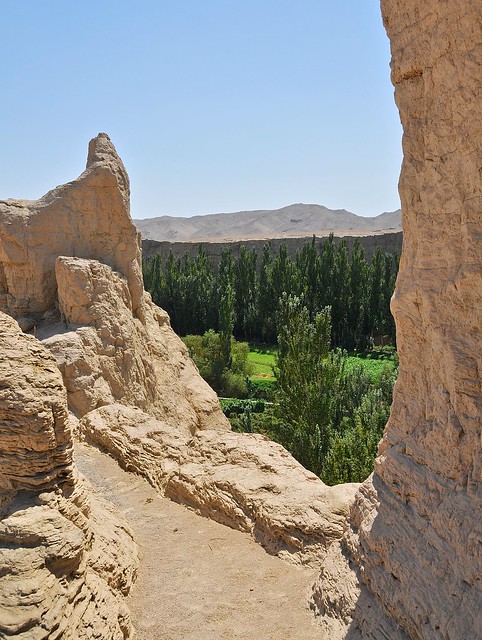 |
| Looking down into the ravine. |
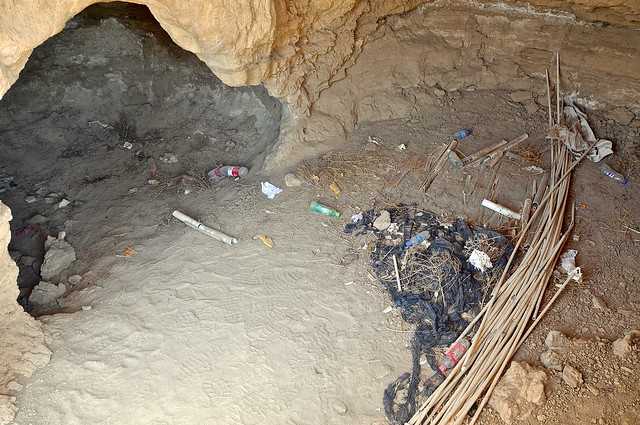 |
| A cave used as a garbage pit, and not cleaned by the park employees. Other caves were used as toilets. |
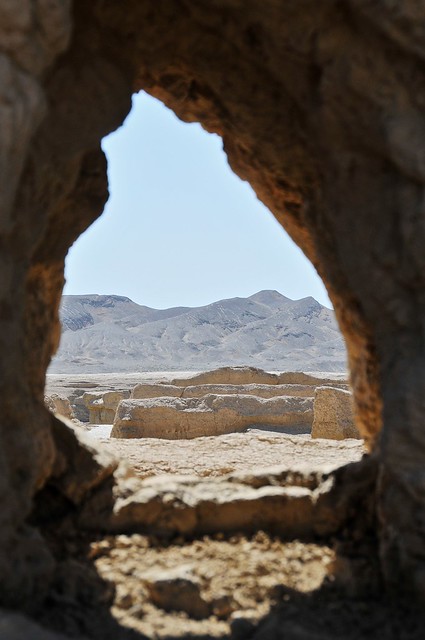 |
| Some of the walls had surviving windows. |
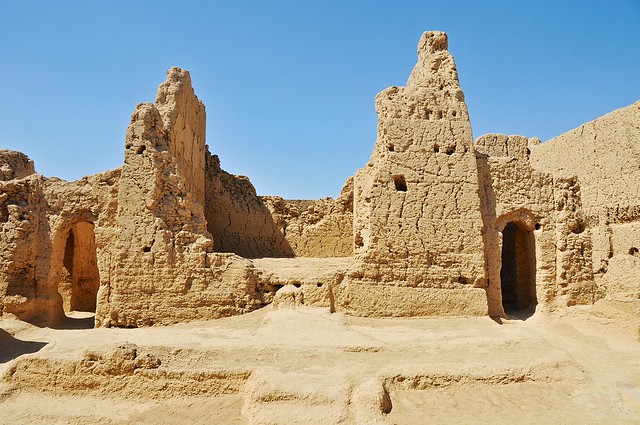 |
| Ruin of the main temple. |
 |
| The old Buddhist stupa area with northern mountains in the background. |
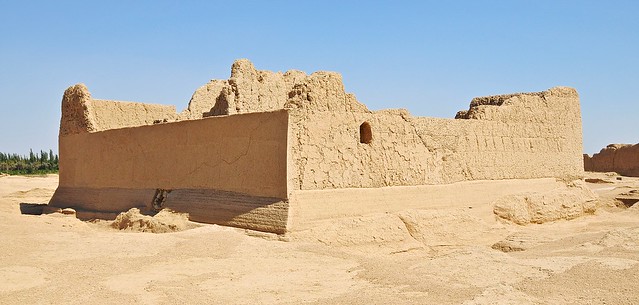 |
| The back of the main temple. |
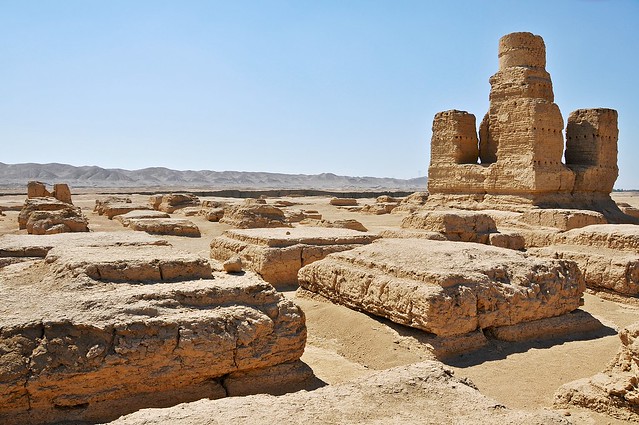 |
| The central main stupa was originally surrounded by four groups of 25 stupas, all arranged on a grid, for a total of 101 stupas. |
 |
| It's an interesting arrangement I've never seen before. |
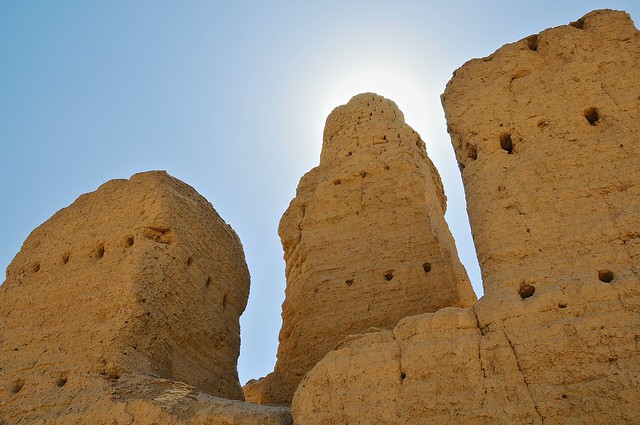 |
| The main stupa from below. |
 |
| The ravines are like little oases. |
 |
| Typical Jiaohe
ruins. Some of the better preserved buildings were partially
underground, and so much of their walls are the walls of a pit. |
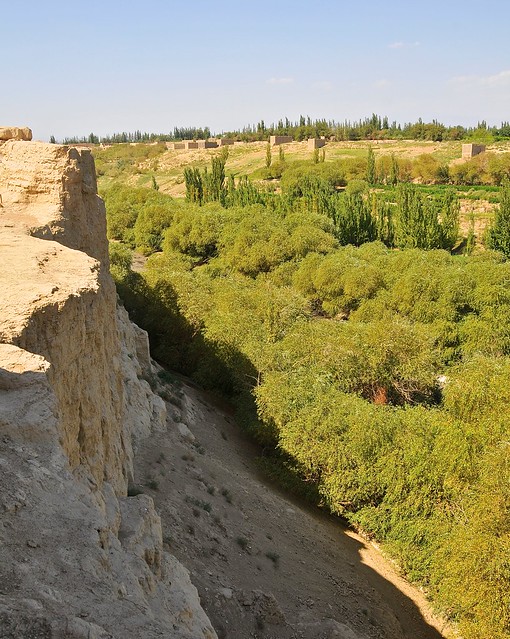 |
| From the northern side of Jiaohe: river canyons on both sides. |
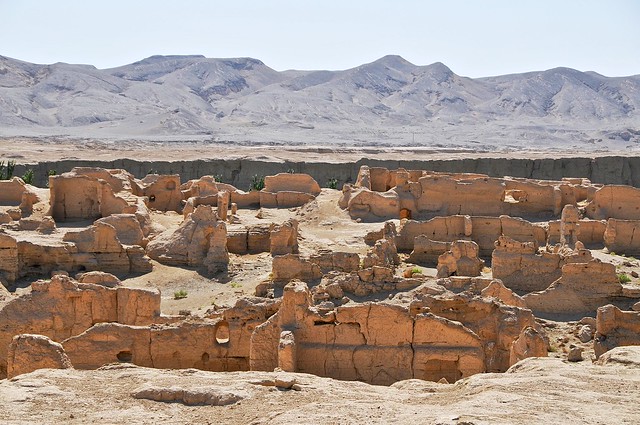 |
| Looking south at the ruins. |
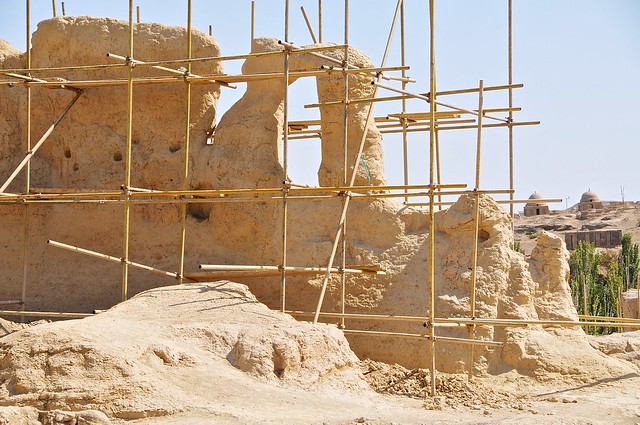 |
| Scaffolding for restoration. I wonder what the site will look like in 10 years. |
Bus to Urumqi
Urumqi is less than 200 km from Turpan, so there was no way to take a
night bus. I ended up taking a bus around 6:30, arriving in Urumqi
around 8:30. Both of those times are Beijing time, which is the official
time everywhere in China. Of course, Turpan is more than 2,500 km west
of Beijing, which puts it functionally in another time zone. Thus it is that Xinjiang
effectively runs on Xinjiang time, which is 2 hours behind Beijing
time, although official schedules are in Beijing time. So the printed ticket
was for 6:30 pm, and the listed schedule was for 6:30 pm, but when
buying the ticket (or asking for times) you would have to specify you
wanted a 6:30 Beijing-time ticket, otherwise you might get a 6:30
Xinjiang-time ticket. It can be confusing. In order to preserve the
illusion that the entire country operates on Beijing time, government
offices in Xinjiang have unusual schedules: they'll open in the morning
according to Beijing time (i.e., very early according to Xinjiang time),
then take a long lunch break and operate the afternoon according to
local schedule. So they might be open from 9:00-1:30, take a three-hour
break, then re-open from 4:30-8:00. I tried to operate on Beijing time
as much as possible, as it made it psychologically easier to wake up
earlier.
Before taking the bus I bought some Xinjiang naan, which quickly became
my go-to snack for quick and delicious eating. I would come to discover
that throughout Central Asia they make naan flatbreads baked in tandoor
ovens, similar to how they do in India, but I was very surprised when I
initially discovered it in Xinjiang. This bread is less soft than Indian
naan, and maybe chewier, but it tends to be much tastier due to the
spices it is cooked with.
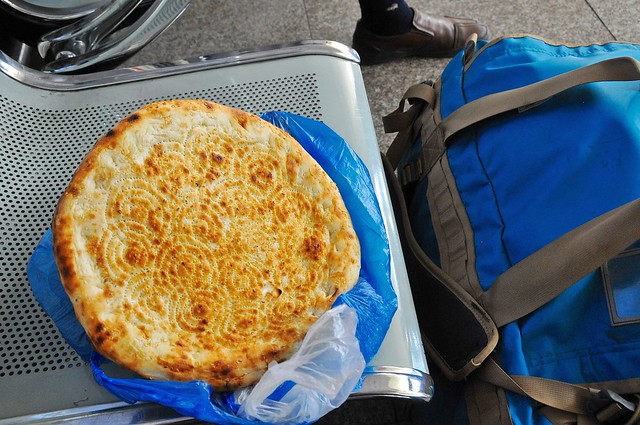 |
| Possibly the best
bread in the world: Xinjiang naan. Nice and thin in the center, puffier
at the edges, seasoned with very finely diced onions and salt, and
cooked in a tandoor oven. Less than 2 yuan, and usually 1 yuan. They
have other types of naan in Xinjiang, but this is the most common and my
favourite. |
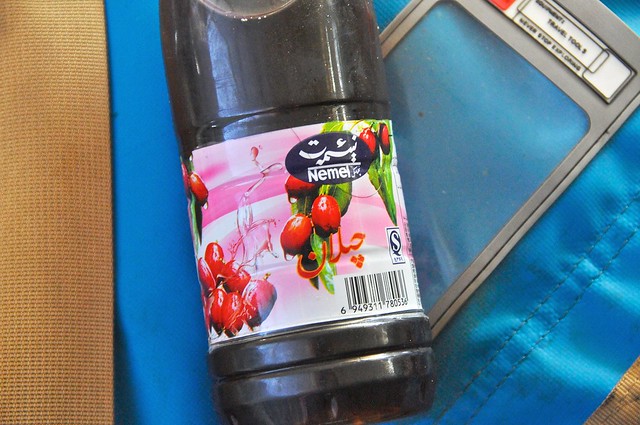 |
| Jujube drink. Not my favourite. |
 |
| This black
currant drink is amazingly tart and refreshing. Easily my favourite,
with pomegranate being a distant second. The beauty is that these are
often sold frozen, depending on how deep in the cooler you dig and the
time of day, so you could be assured they would stay cold for a while. |
Budget
August 18 in Turpan: 135 yuan
- Dorm room at Turpan Hotel: 50 yuan
- City bus x 4: 4 yuan
- Emin Ta minaret: 30 yuan
- About 6 liters in drinks: 34 yuan
- Fruit: 16 yuan
- Dumpling soup: 8 yuan
- Bread: 3 yuan
August 18 in Turpan and Urumqi: 166 yuan
- Bus to Urumqi: 45 yuan
- City bus x 3: 3 yuan
- Jiaohe: 40 yuan
- Urumqi Maitan hostel: 55 yuan
- 4 liters of drinks and naan: 23 yuan



























































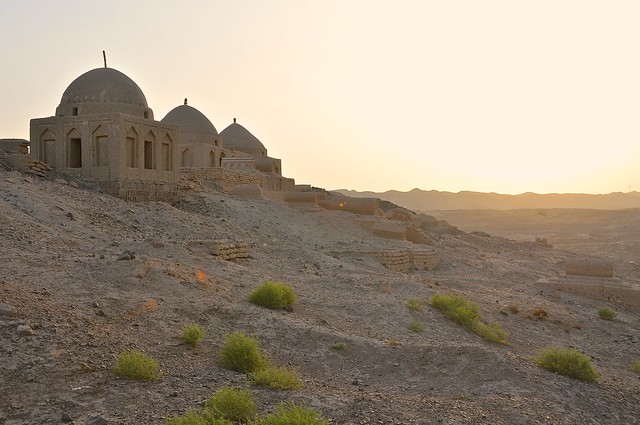


No comments:
Post a Comment